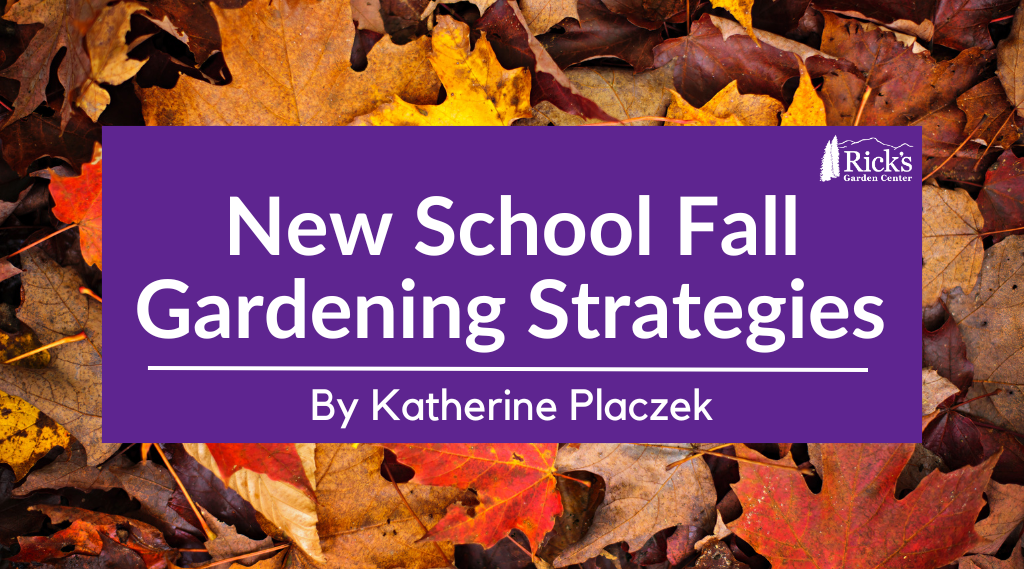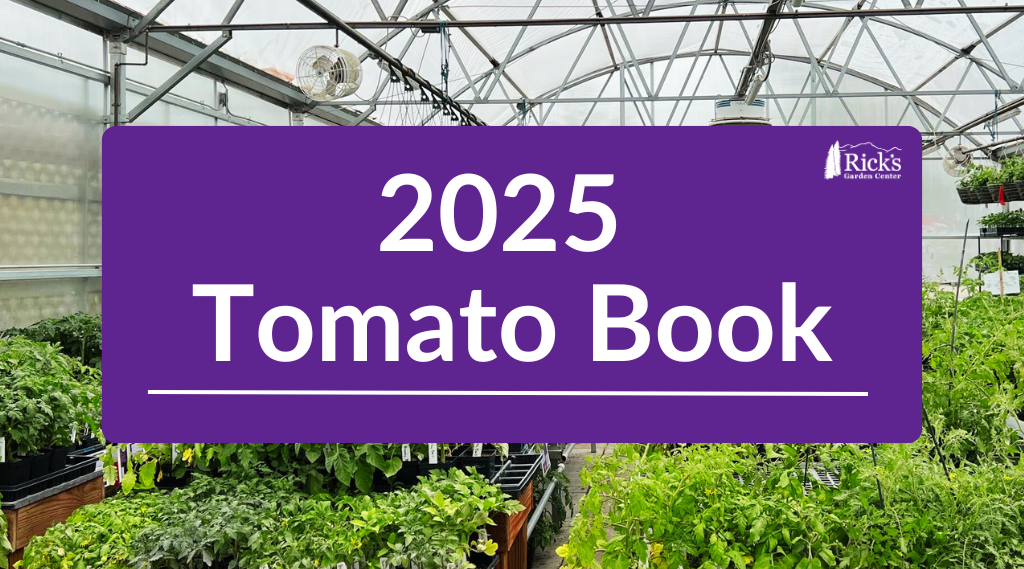Planning For Trees
Gardening is for everyone, and that includes those who want a tree! How can this be? Not everyone has the space for these kinds of big plants. Not so fast-trees also include bonsai and indoor citrus too! Whether you want something decorative, fruiting, or just plain cool, we will help you pick and care for a tree that will thrive!
What To Look For: Location, Location, Location!
Trees are surprisingly delicate plants. Selecting the right plant, planting it at the optimal time, and choosing the ideal location is crucial for a tree to thrive. We’ll first go over site selection. Trees need space both above and below ground. Their canopies need to spread alongside their roots so they can establish themselves easily and live a long time. Keep in mind a tree’s full size before purchasing. If you’re lacking this space, a dwarf tree variety or even a shrub would be better.
Drainage also is important. Most soil in Colorado retains moisture poorly, however there can be areas with poor drainage in any environment. Picking a drought-tolerant tree would be best for soil that poorly retains moisture, the very best being a native tree. For a tree in a wet area pick one that enjoys damp soil, just don’t forget to water during the drier months!
Lastly, sunlight exposure is essential for trees (and generally all plants). Generally, trees need full sun but some don’t like bright hot light and prefer partial shade. Most trees we carry in our nursery will have little information packets attached to their branches about light requirements. If they don’t, our Ricksters are always happy to help!
What To Look For: Healthy Trees Please!
Now we get to the fun part: picking out the tree! Picking a healthy tree will benefit your wallet and the health of your garden or yard. An unhealthy or sickly tree can transmit disease and decay to other plants, so knowing what to look for while shopping is essential for everyone! Tree leaves shouldn’t be wilting, have discolored bark, odd spots, or oddly colored leaves. You shouldn’t buy a tree that has non-beneficial insects, like aphids or mealy bugs, on its leaves, branches, or bark. Trees should have evenly spaced branches and a central branch that acts as the main trunk. The Colorado State Forest Service suggests, “Tree foliage and branches should be distributed on the upper 2/3 of the tree.” Study the tree roots too. Are roots circling, appear pot bound or are suffocating the stem and trunk of the tree? These are all bad signs and this tree shouldn’t be purchased.
Why Natives?
Some trees will do better in Colorado than others. Native trees in particular are hardier and built for our drastic climate. Generally, they will also need less maintenance, like less watering, pruning, and insect control. Natives will thrive in Colorado hardiness zones, though there are always exceptions. A great place to check out native trees and shrubs is at Colorado State University Extension. Alongside pictures, each tab is filled with information about the plant’s preferred elevation, habitat, and more. Click the link to learn more: https://csfs.colostate.edu/colorado-trees/colorados-major-tree-species/
Planting
Trees have specificities when it comes to planting. When you choose to purchase a tree from our nursery, we’ll typically send you home with one of our tree-planting guides. It’s also available on our website, link located here for ease: https://www.ricksgarden.com/wp-content/uploads/2021/04/Ricks-Tree-Shrub-Planting-Guide.pdf .
We want to remind you to NOT FERTILIZE your tree for the first year! This can damage and even kill a tree. Trees are getting established in their new home and this is a stressful time. Applying fertilizer adds unnecessary stress in the first year.
Whether you choose a flowering crab apple or go the native route and pick a tree that easily establishes in our area, finding the right fit tree is what we should all strive for. A chosen tree should be picked to thrive in your yard’s microclimate. Once established, trees return the favor. Providing shade, habitats for animals and birds, cleaning the air and water, and limiting rain runoff are just a few of the reasons a tree can benefit the community. Likewise, trees increase property value and cut noise pollution! Trees are legacy gifts to the environment and to future generations. Whatever your reason is for choosing a tree we’re happy to help you do it right. Happy gardening!

Preventing Water Loss
We understand it’s not easy to garden this year-especially with how expensive watering can be. Trust us, it’s no easy feat to maintain watering our plants either. But we don’t think you should have to give up gardening entirely. Knowing and understanding water loss will help prevent it, saving you money and protecting the environment! Gardening is for everyone and water costs shouldn’t stop you.
Reduce Evaporation
Colorado is notoriously dry. Combined with a hot summer, it creates treacherous environments for gardens. “Thanks to capillary action throughout the soil, which draws water up from below,” says Rhonda Massingham Hart, author of “The Dirt Cheap Green Thumb,” “evaporation can deplete water from deep in the ground.” If you don’t want water to leave your soil, mulch over the top. Gorilla hair maintains water the best and as a perk clumps, so it won’t blow away either. Another good mulch is straw! And if you lay gravel on top, which is also an excellent mulch, it will keep the straw down for you. Gravel mulch however retains heat. In the dog days of summer, this can lead to trouble. If you’re interested in free mulch and willing to work up a sweat, check out the cities free mulch pile: Click here!
Likewise, consider putting down a drip system or soaker-style sprinkler head. Sprinklers that disperse through the air lose more water than these close-contact irrigation systems. If you don’t have the funds for an irrigation system consider purchasing or making olla pots! This technique hails from ancient Northern Africa & China and involves an unglazed terra cotta pot used for underground irrigation. Due to the porous nature of the unglazed terra cotta, the water leaches slowly into the soil. And because the olla put is partially buried or almost totally buried underground, water is less likely to evaporate. To make your own gather terra cotta pots (they cannot be glazed), plug the drainage holes, and place a lid over the top of it. To learn how to make your own olla pot, watch this short video: Click here!
You can also use plastic containers, like old milk jugs, to create olla pots. Wash out milk containers then puncture three holes on the bottom with a hammer and nail, knife, or other cutting tool. These holes shouldn’t be large. Bury the container up to the neck and remove the cap. Fill with water, screw the cap back on, and viola! Plastic olla pot! Keep an eye on when to refill your olla pot and tailor the size of the container to the plant. This too goes for terra cotta olla pots.
Amendments & Native Plants
You can add amendments to your soil to retain and even attract water. Ever heard of humus? Humus is essentially composted plant and animal matter, yet it’s different from typical compost. Our brand of humus we sell is made only with plant product and is one of thew few vegan style compost we provide. Dark in color and rich in nutrients, humus is also excellent at conserving water. Its presence within your soil lessens water percolation and keeps it “in reach” for plants. Likewise, it also slowly releases nitrogen, sulfur, and other essential amendments to plants over time. If you’d like to learn more about humus, read this article and scroll to pages 212-3: Click here!
On hot summer days, plants sweat like us. “One large shade tree can transpire several hundred gallons of water through its leaves,” remarks Rhonda Massignham Hart. While this tidbit of information seems contrary to the information above about reducing water evaporation, misting plants on especially hot days will likewise retain water. This shouldn’t be done every day however, reserve misting for only the hottest and driest of summer days. Native plants are less likely to transpire as non-native because they are adapted to Colorado’s semi-arid climate. If you’re tight on cash for water yet are looking to plant something new, always always ALWAYS choose native. Not only will these plants be saving you money but also you’ll also be helping the environment by returning native plants to the ecosystem! Don’t be surprised if your plants attract more beneficial bugs, birds, and even larger wildlife. Here at Rick’s we’re especially focused on trying to increase our native perennial selection for this reason. If you want certain qualities of native plants, here is a great way to select what you want before shopping at Ricks: Click here!
Conserving water doesn’t have to be scary or expensive. With these hacks, you’re sure to save on your water bill. Here at Rick’s, we’re excited to share more gardening tricks and tips. No one should ever have to give up gardening due to money or to the environment. Gardening is for everyone!

Encouraging Kid’s Green Thumbs
There is a saying that “green thumbs are not born, they’re grown.” And here at Rick’s we heartily agree! Green thumbs come in all shapes and sizes, and even ages. Today we want to encourage younger green thumbs- kiddos! Kids are naturally attracted to dirt, worms, flowers, bugs, watering cans, seeds, berries and even veggies that are unique. It really is quite easy to get them hooked on becoming gardeners. Some may balk at including kiddos in the garden. What if they mess things up? I counter, adults also mess things up in the garden- often without trying. Let the kids learn, experiment, play and succeed in the garden. If you are a parent, teacher, guardian, devoted auntie, grandparent, or other care giver, these tips will get you started on introducing kids to the wide world of science and beauty of plants.
Gardening is an adventure into math, science and art. Math is used when discussing how far and deep seeds are planted, as well as in the conversation of, “If we have three eaters in our home, how many zucchini plants do we need to plant?” There is no right answer for this conundrum, because you typically end up with too many zucchini in general. But having that conversation with a child allows them to think of the production of one zucchini plant, how to extrapolate how many ways they and other eaters can eat zucchini, and to problem solve with what to do with any extras. Maybe the neighbor next door would like some?
Science takes a look at the immediate needs of a plant; nutrients, water and sunlight. But as a kiddo becomes more advanced in their gardening skills, you can begin talking about seed production, pollination, photosynthesis, soil biology, mushrooms, diseases, pests and the list goes on! Perhaps most importantly, it may be wise to share why gardening is so important to embark on in this time and age. This can cover creating habitats and safe zones for pollinators, building food sovereignty and security while avoiding supply chain disturbances, farming for the purpose of carbon sequestration, etc. And the variations on this theme grow infinitely from there.
Of course art goes hand in hand with gardening. Design and edibleness are dependent on aesthetic values. A child will love choosing pansies (some look like tiger stripes!), colorful zinnias, snapdragons, and other annual flowers for their container garden. Consider taking them through the perennials section for in season cut bouquets, including daisies, black-eyed Susans, Penstemons, and Yarrow. They may want to try purple carrots, purple tomatillos, purple beans or peas, or eggplants if the kiddo’s favorite color is, you guessed it- purple! Challenge them to create colorful dishes with the veggies you all grow. “Can you create an all orange meal? All green? Red? Can you have every color of the rainbow represented on your plate?” Growing vegetables for their colors is not only fun, it is healthy! Produce that have unique colors often are chock full of vitamins, antioxidants and other nutrients that we may neglect to get through our Standard American Diet (SAD).
Other ways to encourage the gardener in every child:
- Pick out seeds together to grow by inviting them to take a look at a seed catalog or a seed company’s website. If you are looking for wild and very colorful seeds, Baker Creek Seeds is a great start!
- Grow sprouts or microgreens if you are lacking space, but want a child to see the life of a plant from seed to germination to the plate. See our other blog this month for details on how to grow microgreens!
- Grow things that create awe and wonder like:
- Sunflowers
- Beans
- Pumpkins
- Small cherry tomato varieties (Spoon is a great variety, because it is abundant and kiddos love the “baby” tomatoes)
- Raspberries and blackberries
- Plant a tree, and talk through how trees are important for creating habitat, providing oxygen, cooling of the climate and are a generous resource for paper, fruit, and wood.
- Plant fall or spring bulbs for children who may need an example of delayed gratification. Plant the popular daffodils in the fall and watch them bloom in the spring. Or plant gladiolas now and watch them pop up late summer.
- Build an observation habitat: Plant flowers and other plants that will attract hummingbirds or other pollinators that the children love (butterflies, bumble bees, etc). Place a bench beside the habitat and have children tell you what they see, hear, smell, feel, etc. This prompts quiet patience and the building blocks for scientific inquiry.
- Begin a worm or compost bin. Collect kitchen scraps, shred old school work, or bills and throw in a generous community of worms. Children will be amazed to watch these items turn into worm castings, or worm poo, and how it can be used in the garden or with house plants.
A kiddo who eats their first carrot or snap pea from the garden will never forget that moment. While gardening is magical as a child, being an adult and witnessing the magic is priceless. Green thumbs can grow at any age and stage, but it is a true gift to give the love for gardening to a child. They have the rest of their lives to grow with it!
Rick’s Garden Center believes in the power of people and plants. All of our blogs and content are written and edited by real humans with their own unique creative perspectives. Any use of our publications to ‘train’ generative artificial intelligence (AI) technologies to generative text is expressly prohibited. Any typos or errors are our own
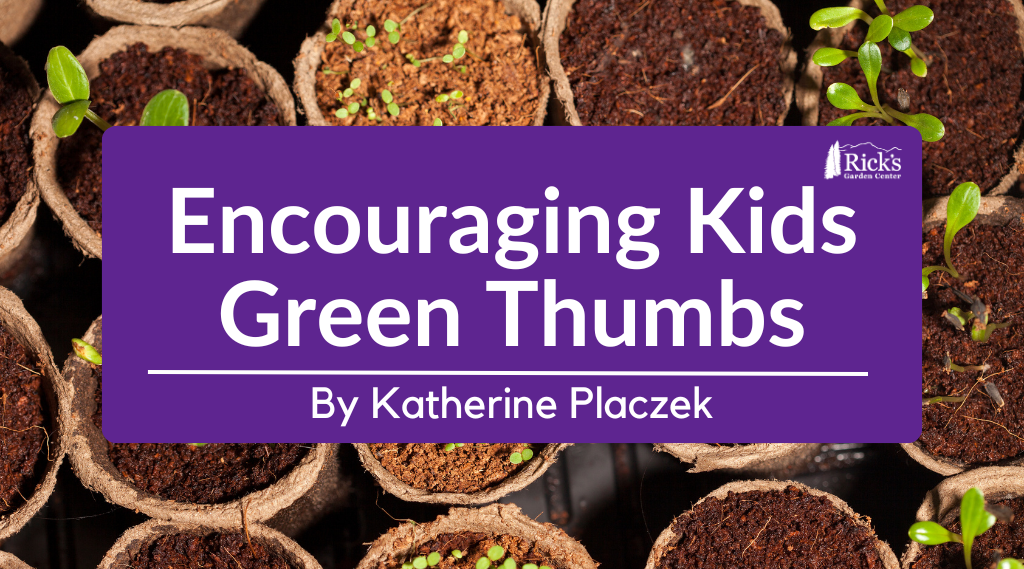
2025 Garden To-Do’s Recap 1#
Here are the gardening references we shared over the past month. We’re big fans of Colorado State University extension, so you’ll see us referencing them all the time. However, we also have some written articles just for you under our blog! There will be more gardening references for the year, so stay tuned!
Relative Houseplant Care/Rescuing House Plants:
Listen…shhhhh…if you listen closely, you can hear that neglected plant in the corner crying for help. You did not mean to cause harm. Whether you left for your holiday travels in a rush and failed to give your plants some extra TLC before you left, or you do not know the plant’s needs, the stress is equally killing you. You are at the point of not knowing what to do to make your plants happy again. No worries! We got you on our blog!
Starting Seeds Indoors:
We know it seems early, but the sooner you start your seeds the better. For tomato and pepper plants it’s recommended you start them outside once soil temperatures reach 50 degrees at night. This however doesn’t work well for Colorado’s short growing season. To get the most produce out of your vegetables we recommend starting seeds indoors now and in February! All you need is a seed-starting soil mix and a grow kit!
Seed Starting Troubles:
Have you been waiting for your seeds to pop up and still nothing? No matter what you do, your seedlings perish. There are multiple factors as to why your seeds may not be sprouting. Seed age, crusting soil, and temperature fluctuation are just a few. In the article below by CSU Extension, scientists review why your seeds may not thrive as they should. Fear not, solutions are provided to fix issues and to get those seeds growing! Happy gardening!
Winter Watering:
If air temperature is above 40 degrees it’s time to winter water! Read more about winter watering rules below!
https://www.csu.org/blog/winter-watering-tips
Do’s & Dont’s of Transplanting:
Want to get bang for your buck when starting transplants? Learn the dos and don’ts of growing transplants by copying and pasting the link below! And if you need containers we wanted to remind you we have a free drop off/pick up bin behind the store in our parking lot-perfect for starting seeds or other transplants (once they’re clean that is)!
Garden Planning:
Now’s a great time to start garden planning for spring! Remember to consider space when mapping your beds and companion plants! The links below will lead to more information about early garden planning and companion plants!
General Info:
Companion Plants:
General Onion Care:
Intimidated by growing and planting onions? How about storage, before and after planting and growing these flavorful bulbs? And what the heck does daylight have to do with all of it?
Among the hundreds of questions involving onions you may have, we’ve contacted the experts for their advice. Learn the essentials for onion care from Dixondale Farms!
Growing Potatoes at Home:
Want to try growing potatoes this season in your home garden? We have a link for you! We recommend reading Colorado State University article on the subject!
https://extension.colostate.edu/topic-areas/yard-garden/potatoes-in-the-home-garden-7-617
Spring Bulb Care:
Intimidated by growing spring bulbs? Don’t be with Colorado State Extensions help! Learn how to keep beautiful spring bulbs, corms, and roots alive by reading the article below or in our story/highlights. The article provides everything from choosing a perfect planting spot to planting depth for certain favorites Happy gardening!
https://extension.colostate.edu/topic-areas/yard-garden/spring-planted-bulbs-corms-and-roots-7-411
Rick’s Tree Planting Guide:
We know many of you are familiar with our Tree Planting Guide, so here it is again! This guide is perfect for those interested in buying a tree or about to plant a new one. We also sell mulch, root stimulators, and mycorrhizae for tree planting! Happy gardening!
https://www.ricksgarden.com/wp-content/uploads/2021/04/Ricks-Tree-Shrub-Planting-Guide.pdf
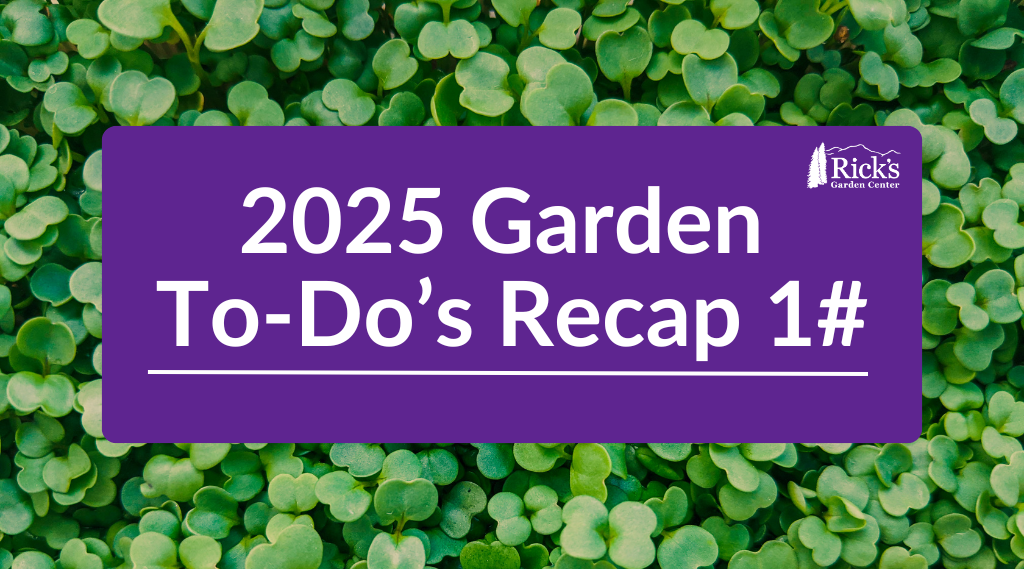
On Crop Failure
By Emma Seibert
A few nursery Ricksters had been growing tomatoes in our greenhouses this winter as an experiment. In hopes of helping gardeners sample certain varieties before they commit to growing, nursery crew member Emma was dedicated to growing tomatoes and selling them as produce over the winter. Accidents happen to the best of us, however, including garden centers. Though crop failure is tragic, it’s not a sign to stop growing. Rickster Emma will talk you through her recent experience with crop failure…
A regular part of my job, especially in the summertime, is helping customers troubleshoot the issues they are seeing with their vegetable gardens and flower beds. Sometimes customers come in and I am able to recommend different caregiving techniques that can help bring their plants back to full health. Other times, I have the unfortunate job of bearing the news that the plant in question is either beyond saving, or even more heart wrenching, that it is dead. And that is what I wanted to talk about today. Dead plants are a rather sensitive topic for most growing enthusiasts; whether you’re a farmer and the health of your crop determines your livelihood or you’re just beginning your houseplant collection, crop failure is painful.
On August 26th, 2024, I seeded 32 tomatoes to plant them in large farm troughs in one of our greenhouses, with the intention of sharing the organic, local greenhouse-grown fruit with you all during the cold winter months. We wanted to provide our community with locally grown, ‘out of season’ produce that was flavorful and that you all could feel good about purchasing, knowing exactly where it was grown.
On January 13th, 2025, the tomato plants were nearly touching the roof of the greenhouse. They were blossoming and nearly every plant was fruiting. The green globes that hung from the tender stems had a yellow hue, indicating that ripening was mere days away. The stripes on the Purple Bumblebee tomatoes were starting to darken and the folds in the skin on the Sub-Arctic Plenty were beginning to smooth out, firming up the skin and giving it a glossy appearance. The first harvest date was so close I could nearly taste the tang of the Sweetie cherry tomatoes.
Then that same evening, the heater in the greenhouse wouldn’t turn on, despite the thermostat readings dropping. For some reason the thermostat and the unit heater were not communicating, but we couldn’t figure out why. As I got in my car to go home that night, I tried to remain hopeful that something would kick on, that someone would be able to figure out what was wrong in the next 20 minutes before the store closed for the night; all while watching the temperature readings in my car drop below 32 degrees.
The morning of January 14th, I hustled to the greenhouse as quickly as I could. Before I could even open the door, I knew it was done. There was frost coating the inside of the greenhouse walls; it had gotten cold enough inside for the condensation from the previous day’s healthy plant transpiration to freeze, indicating to me that every tomato plant inside must be frozen too. I went inside anyway and saw what I already knew to be true; every beautiful plant was frozen in time. The leaves were slightly wilted but maintained their vibrant green color, iced over in the moment of their last breath. It turns out that the safety fuse in the greenhouse heater blew out the previous day, preventing the heater from turning on despite the thermostat telling it to do so. We were unable to replace it in time for that night’s low of 10 degrees. As the daytime temperatures rose, the cell walls thawed and tomato plants flopped in defeat, their fruit turning to mush in my hands.
I cried, really hard. For a long time. I am not telling you this story to make you sad or say woe is me and my little crop of tomatoes. I am telling you to try to be of comfort; crop failure happens and hurts at every stage. I am telling you because I want you to know that yes, crop failure is a fact of life in the horticulture world. And also, the pain associated with such loss is a fact of that life too. So if you come in to show me your plant that is struggling and I tell you that it is dead, know that I understand that pain too. And I will do my best to help you pivot your crop, like I did with mine.
After the sore task of digging up all of the spent tomato plants, I went back and seeded some other, more cold-tolerant crops. And soon, the greenhouse will be a miniature forest again, but this time of kale and spinach, lettuce, and Swiss chard. I am not perfect, and neither are you, and neither is anyone no matter the extent of their experience. We all have to pivot sometimes and just know that the pivot can be the seed for new success.
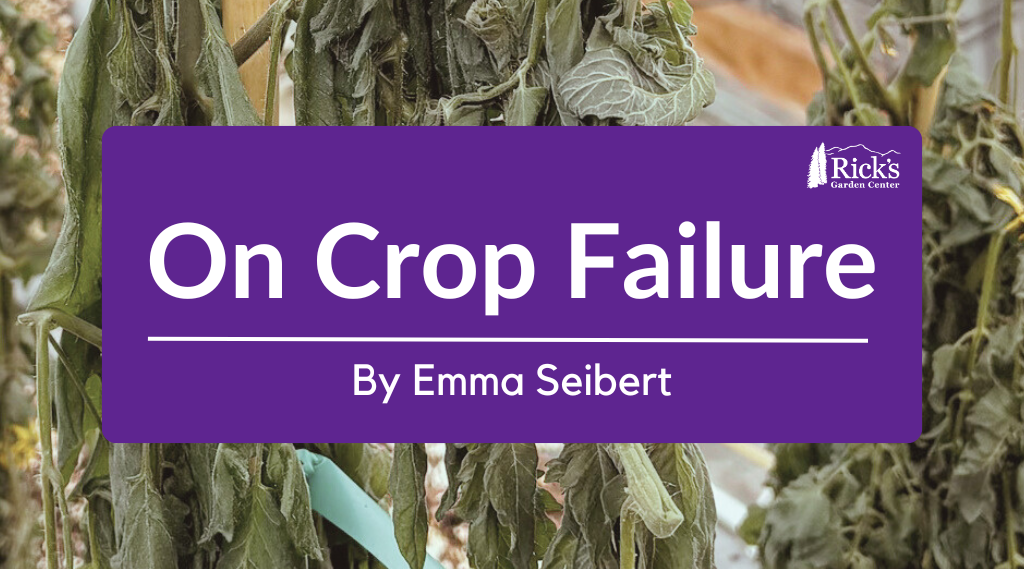
Rescuing Houseplants
Listen…shhhhh…if you listen closely, you can hear that neglected plant in the corner crying for help. You did not mean to cause harm. Whether you left for your holiday travels in a rush and failed to give your plants some extra TLC before you left, or you do not know the plant’s needs, the stress is equally killing you. You are at the point of not knowing what to do to make your plants happy again. No worries! We got you.
First:
Get nerdy. Pretend you are a scientist. Observe the plant. See what its symptoms include. What is it trying to tell you? Do research by using reference guides. We recommend The Plant Rescuer: The Book Your Houseplants Want You to Read by Sarah Gerrard-Jones (available at the Pikes Peak Library District). This book has helpful decision trees that will help you decipher your plant’s calls for help. Also, feel free to search the web on general care for your species of plant. Cross-check with multiple sources, so you are getting good and correct information on what your plant needs. Academic sources and search engines, like Google Scholar, are excellent places to find accurate knowledge. And plant communities on Reddit surprisingly are always insightful. Feel free to bring photos to us, and we can help diagnose what is occurring!
Second:
Based on the initial sleuthing you did through observation, reference books, internet searching, and inquiry, come back to the plant. Address the habitat first. Habitat includes light, moisture, heat, and humidity. Is your cactus in a dark corner? Is your Norfolk pine crisping up because it is in direct sun? How about moisture? Does your plant look like it is dehydrated, and needs a drink? Or conversely, has it seen too much water and would love to dry out its feet? Is your plant feeling a chill because it’s by a cold window? Or is it dropping dry leaves because it is in proximity of a heater vent? Some plants do not want to be drenched with water, but like the daily mist of a shower, a spritz of a spray bottle, etc. Are you giving those plants the humidity they need? If you have adjusted the habitat of the plant to fit its individual needs, and still do not see improvement in 7-14 days, move on to the next tier of help.
Third:
This next tier of inquiry is about pests, plants that are rootbound, and fertilization. Typically plants that were left for themselves for a couple of days and look sad will not need help from this stage of help. Plants that have fended for themselves for weeks while you were working on that big project, or you have mistakenly overwatered several times, or are just ready to go to a larger home are typically when you will see any of these concerns.
Pests come in all shapes and sizes. The most common pests you will encounter are house gnats, white flies, aphids, thrips, mealybugs, and scale. Another pest that occasionally shows up is various fungi. Some of these concerns are easy to get rid of, and some are extremely difficult. While this article does not have the space for the breadth of how to address each of these species, you should consult your resources (like The Plant Rescuer, or give us a call!).
Rootbound plants may present as under-watered but are typically not happy even after you have watered them. Check for roots poking out of the bottom of a drainage hole, or pull the side of the soil away from the pot to see if roots have encircled the base of the pot. If the plant is rootbound, up the pot to a container 2 inches wider than the current size.
Finally, nutrients may be what your plant is asking for. A nutrient deficiency can present as yellowing leaves, absence of blooms (as an example, begonias typically need fertilization to bloom), slowed growth, or languishing properties. Find a fertilizer that will suit your plant (cacti and succulents do not need a whole lot of fertilizer, so do not go straight for the all-purpose 20-20-20.) If you are not sure that your plant needs fertilizing, start with a diluted or lesser amount than advised on the container. You can always make a situation worse.
If at any point you lose a plant along the way, know it happens to the best of us. Take heart, there are other plants out there, and this is not an indication of your skill level as a plant person. Part of the journey is losing plants occasionally, sad as it is. Say last rites, find a peaceful resting spot for the plant (the compost is a nice spot), and fill the empty corner with a new plant friend. If it is too soon for that, take the time you need. We will be here when you are ready. Peace, Love & Plants.

Holiday Houseplant Care
So many of us travel around the holidays- sometimes traveling the whole stint of Christmas through the week of New Year’s. This stretch can be long for plants (and you- depending on who you are visiting and how long the trip is), without their regular TLC from you. Our easy-to-follow tips to ensure your plants look amazing after your holiday hiatus.
Moisture
All plants have different moisture needs. Some will need closer attention, and regular watering, even while you are gone. If this is the case for some of your plants, you can implement a self-watering system such as a plant watering globe, plant nanny, or drip irrigation system. A drip irrigation solution is as simple as filling a container of water, and then using a strip of yarn or other water-wicking material immersed in the water to have it “transport” water to the plant in need.
If you prefer, feel free to lean into your community. Ask a neighbor to water while you are gone. Ensure you show them exactly how you water, and how often, so they do not over or under water. Winter air in Colorado is dry. Some of your houseplants will benefit from added humidity. A humidifier on a timer or a DIY humidity tray are great solutions for when you travel. A humidity tray can be as simple as a ceramic drip tray filled with pebbles or clay balls/LECA. Fill the tray with water, and place your potted plant on top of this set-up. Anything that evaporates will immediately be absorbed by the plant.
Mulch
We typically think of mulching as a technique to utilize outdoors, but this technique can also be used indoors! Mulching can help retain moisture during short periods. Use fine-grade orchid bark as a top dress for houseplants that need extra care. Once you have mulched, regularly check that these plants are not retaining too much moisture.
Light
Winter can be a challenge for some houseplants, especially tropical houseplants native to the region around the equator. The equator experiences more consistent sun exposure year-round. You probably have noticed the increased darkness during the winter months in our region. Thus, some of your houseplants may be craving more light right now. Move any plants that need more light to a sunny window, or beneath a grow light on a timer. With temperatures dipping in the winter months, make sure you are aware that the window you place your plant by is transmitting those cold temperatures indoors. No house plant likes a cold draft!
Temperature
As alluded to in the above paragraph, temperature is key to a plant’s happiness! Winter brings new variables for plants. Cooler temperatures translated through windows can cause frost, so move plants that may be susceptible. We also have heaters running in the winter. If you have a plant directly over a vent or radiator, you may see leaf drop or “burnt” leaves. Move any plants that could be affected. Some of these signs will show up only after you have spent time away, so it is helpful to address these risks ahead of time.
Maintenance
While some of us may leave house plant maintenance at the bottom of our to-do list, it is important to address it before you leave for an extended time. Many problems that are riding under the surface can rear their head if left unchecked. This includes any existing pest concerns. Preventative measures can include wiping houseplants down with diluted neem oil and a rag. Neem works as a leaf shine, micro-nutrient, and pest repellant. Other maintenance may include trimming any dead or languishing leaves and stems, so pests cannot get a foothold while you are gone. Trimming in this fashion, also allows plants to conserve energy and focus on being healthy, instead of trying to recuperate in your absence.
Fertilizing
Fertilizing houseplants in the winter is frowned upon since winter is a season of “hibernation” and not growth for houseplants. Winter can be a stressful period for some species due to cold, drier conditions, and reduced light. Fertilizing can present additional stress. Do not fertilize ahead of your travels, where you are not able to observe any drastic changes or your plants’ calls for help!
Now, what if you were unable to follow these recommendations, and you return to a home of sad-looking plants? We will be covering houseplant-rescuing tips next month!
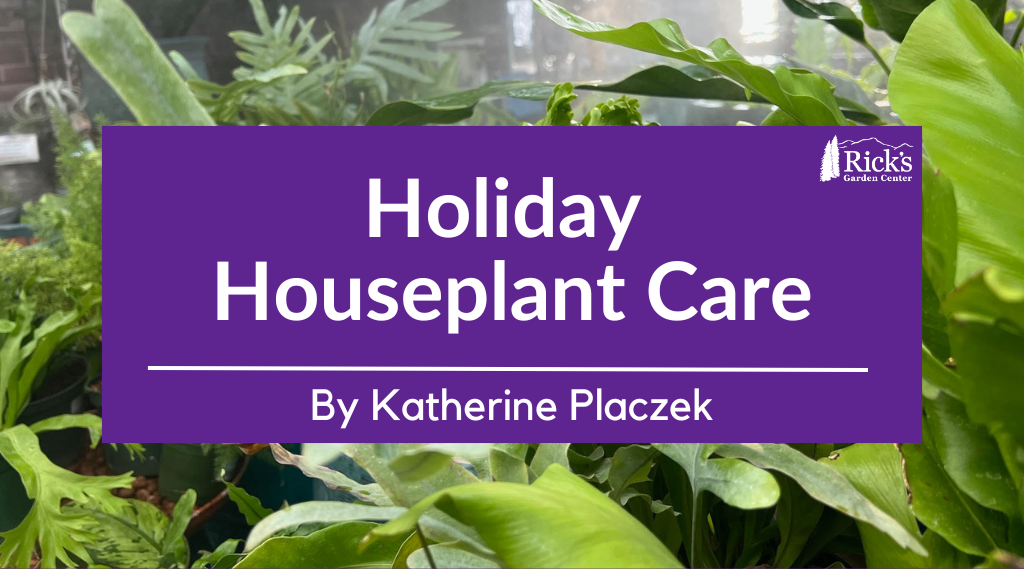
Tool Care Guide
Fall is here! This is a bittersweet moment for me. Harvest has hit its finale, and I am beginning to accumulate a stack of books that will keep me growing while my garden begins to take a snooze. Before I cozy up on the couch, and have a cup of tea- I always take care of my end-of-season garden tool maintenance. Garden tools should have regular TLC, especially after use, but in reality, this may not happen. I will detail daily care at the end of this article for your convenience.
End-of-Season Garden Tool Maintenance:
Deep Clean and Oil Pruners:
This is imperative to reduce disease and rust on your snippers, prolonging their use.
- Pruners should be taken apart and deep cleaned at least once each season.
- Unscrew any nuts/ bolts that hold the pruners together.
- Wash all parts separately in soapy water.
- Soak all parts in vinegar, then rinse with water.
- Rub with steel wool to remove any rust, then rinse and dry.
- Soak in diluted bleach water to sanitize, then rinse and dry.
- Buff with linseed oil and reassemble.
Sharpening:
Both pruners and Hori knives, as well as long-handled tools (hoes and shovels), need to be sharpened every season. Keeping pruners sharp helps produce clean cuts on plants, reducing the entry of any disease. Other tools benefit from a sharpening, making your life much easier. Digging a hole to plant with a dull shovel is no fun!
- Anything you are going to sharpen should be cleaned first. Long-handled tools may not need the vinegar/ bleach/ oil treatment unless there are concerns about rust.
- Push the sharpening file in the same direction across the blade and follow the original blade angle. Do not rub the file or stone back and forth, this does not sharpen but dulls the blade further.
- Smooth these newly filed edges with a sharpening stone.
- We recommend wearing eye protection and gloves when sharpening to protect against metal slivers.
Care for Wood Handles:
With long-handled tools, it is important to take care of wood handles. Utilize durable tape (think athletic tape or other heavy-duty tape) for minor cracks. Anything that is more compromised should be replaced immediately to prevent injury.
- Wipe down the handles with a damp cloth.
- Inspect for cracks or any weak spots between the handle and the tool head. Address with durable tape or replace the wooden handle if damaged.
- If needed, lightly sand the handle to smooth splinters, and rub linseed oil to condition.
Daily Garden Tool Care (when you have time!):
Generalized care:
- Rinse any digging tools, then use a wire brush or something similar to get rid of any stuck dirt or debris.
- Scrub snippers down with a brush and soapy water.
- If any tools were used with diseased plants or infected soil, make sure you disinfect them before any other use. Soak the infected tools in a diluted solution of 2 cups of bleach mixed with 1 gallon of water. Then rinse in plain water, and follow with a generous wipe of rubbing alcohol.
- Before storing tools, rub them dry with a rag.
- To help prevent rust on digging tools, mix a bucket of sand with plant-based oil, like linseed oil (avoid any petroleum oils, as this reduces plant vitality). The sand should be damp with oil, but not wet. Plunge any blades, tines, or teeth into the sand a few times for a quick clean, or do this following regular maintenance once the tools have been wiped dry.
- Store your tools in a dry and well-ventilated place. Small hand tools can be stored directly in a dry bucket of sand or gravel, and larger tools should be hung so as not to dull their blades in a mad scramble.
Removing Sap:
- Wipe blades with a rag dipped in mineral spirits or turpentine.
- Submerge and clean the blades in soapy water. Rinse and then wipe with linseed oil.
Preventing and Removing Rust:
- Soak any tools showing signs of rust in a 50/50 mixture of vinegar and water overnight.
- Scrub the affected areas with steel wool.
- First, wash in soapy water, and then rinse.
- Rub dry and then buff with linseed or a mineral oil.
All tool maintenance requires is a little elbow grease and time. Sometimes we neglect our tools throughout the season, but I can tell you the reward of pulling out a clean, sharp, and shiny tool in the spring never ceases to make me smile. Happy fall, everyone!

New School Fall Gardening Stretegies
By Katherine Placzek
With fall approaching, many of you are getting ready to put your garden beds and other portions of the landscape to bed. With a more eco-friendly mindset, we would like to suggest a couple of tweaks to your typical routine.
Old school: Raking and bagging leaves, tossing them out for the trash.
New school: Rake leaves from below trees, and use them as mulch around your perennials, shrubs, or on top of your vegetable garden beds. You can also run these over with a lawn mower to mulch them into your grass.
Why: Organic matter, including yard waste, is the most prolific item in United States landfills. Consequently, this unsustainable practice directly contributes to greenhouse gas emissions. Conversely, organic material returned to the soil reduces your environmental impact while providing a useful garden resource. These local sources of organic material and nutrition (from your own yard’s leaves) will feed and insulate your yard all winter long! Decomposing leaf matter enriches the soil, adding carbon and nitrogen to the soil, while plants “sleep.” Leaves also create safe places for native bees and other pollinators. Did you know that almost three-fourths of Colorado’s native bees nest and overwinter underground? Tip: Deeply water the leaf litter in after it has been placed. This creates a wet decomposing mat that will not blow away as easily.
If you have excess leaves that you are not going to be using, please feel free to bring your bagged leaves by our nursery gate (located at 600 N. 18th St. Colorado Springs, CO 80904). This is a community pile that other members come to gather for their own gardening usage.
Old School: Trim any perennials and remove them before the first snow.
New School: Leave all of your woody stalks, leaf matter, and ornamental grasses all winter long!
Why: This allows for winter interest and provides shelter for any hibernating insects. This is especially true for native plants that act as habitat for many native and beneficial insects. Larger life forms, including birds and mammals, will also benefit from grass seed heads left standing, and other plants that provide shelter in the harshest months. If this is unsightly for you, trim your plants, but leave the stems and other leaf matter on the ground to help create shelter throughout the winter. When soil temperature has reached 50 degrees Fahrenheit it’s the preferred time to begin trimming these perennials in the spring, after many insects have completed their wintering cycle.
Old School: Let the winter snows water your outdoor plants.
New School: Water trees, shrubs, and perennials on nice days throughout the winter.
Why: Unfortunately Colorado Springs does not get enough reliable winter moisture to overwinter many plants. This is especially true for newer plants that do not have an established root system yet. Many trees and shrubs, even those that are well-established, should continue to be watered on warm winter days from October through March. When it gets up to 40 degrees Fahrenheit, pull out a hose or dust off your watering can and soak up some of those winter rays, yourself, while you water. Make sure you unhook any hoses after use, as temperatures can cause freezing in the hose bib and other hardware.
Old School: Say goodbye to gardening until spring.
New School: Fall and winter sow, including vegetable and perennial flower seeds.
Why: Many annual vegetables and perennial flowers have a natural cycle where they drop seeds or fruit in the fall. Mimic nature and plant some of your own seeds in the fall to see what comes up earlier and hardier in the spring! In the vegetable garden, this especially works for cold hardy greens. Think spinach, lettuce, arugula, radicchio, etc. For perennial flowers, like wildflowers, it is recommended to put these seeds down in the fall, as many of our native flowers require a cold stratification period. While many people may set up sections in their freezer and fridge for cold stratification processes, direct seeding in the fall eliminates the juggling of space in your fridge/ freezer. Let the ice cream stay where it is!
Old School: Wait until spring to amend any of your garden beds.
New School: Amend your garden beds in the fall so you can plant right away in the spring.
Why: Fall is a good time to test your soil so you know how to amend your beds. Our soils typically fall in the basic pH range here in the greater Colorado Springs area. This can impact how readily available nutrients are to our plants. Do your research and get your soil properly in shape for your spring! Remember that you can also amend with what nature provides; leaves, manure, compost, and other organic matter. These sources do not have a precise N-P-K (macronutrients: nitrogen, phosphorus, potassium), nor spelled out micronutrients (calcium, magnesium, iron, etc) so it is recommended to test your soil in the spring again to see how your soil has changed due to any unregulated organic material. We offer pH and N-P-K, testing in-store, but the CSU extension office also offers a wide range of soil tests.
Now that you know these new school techniques, you might just try other new gardening techniques in the growing season. I know, I know- I am getting ahead of myself! Happy gardening!
